Welcome to the secret life of bees! Within our global ecosystem, bees play a fundamental role. Flying from one flower to another to gather their priceless nectar, they also pollinate the plants they visit. This simple action ensures the growth of flowers and plants and makes an irreplaceable contribution to keeping the world’s environment healthy. (From the rulebook.)
I love bees. And I will forever defend them — especially when a wasp goes about sullying a bee’s reputation by masquerading as one. On more than one occasion I have entered into a heated discussion about the differences between bees and wasps and how one shouldn’t assume an annoying pest buzzing around one’s head is a bee. (Recently I was even reading a book and in it the narrator mentioned how bees were bothering them and I grumbled aloud to myself, “they probably weren’t bees, but wasps.”) So it’s safe to say I feel very passionately about bees…don’t say I didn’t warn you.
A wasp is nothing more than a wannabe! Oh, and also I’m Smash. I’ll be popping up throughout this review to tell you some bee facts…and maybe also sneak in a pun or two.
Beez is the sixth title from Next Move Games, a publisher known for creating beautifully colourful games with simple rulesets and tactilely pleasing components. (Other Next Move games include Reef, Tuki, and the Azuls — Azul, Azul: Stained Glass of Sintra, and Azul: Summer Pavilion.) In Beez, two to four players shrink down to bee-size — Magic School Bus-style — and fly around from flower to flower, collecting nectar that they will eventually turn into delicious (and high-scoring) honey. That’s about as thematic as Beez gets because, other than moving around the cutest little bee standee you could imagine, Beez is essentially an abstract strategy game — but a really great one at that.
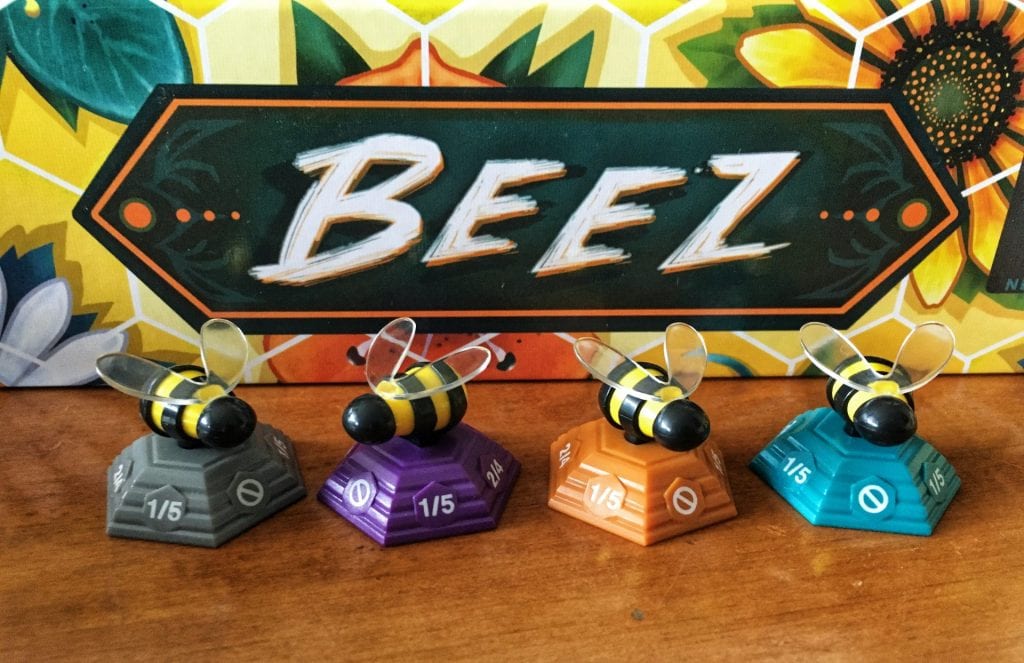
A View From Above – Beez Gameplay
The Beez gameboard is made up of various Flower and Leaf tiles, with each tile composed of seven hexagonal spaces on which a Bee may land. Players starting out may use the suggested configuration in the rulebook, but as you become familiar with the game you’re encouraged to experiment with your own Flower and Leaf tile layouts.

To start the game, each Flower tile will have three small Nectar on it (matching the colour of the flower) and any Flower tiles on the edge of the gameboard will also have a large (matching) Nectar on its centre space.
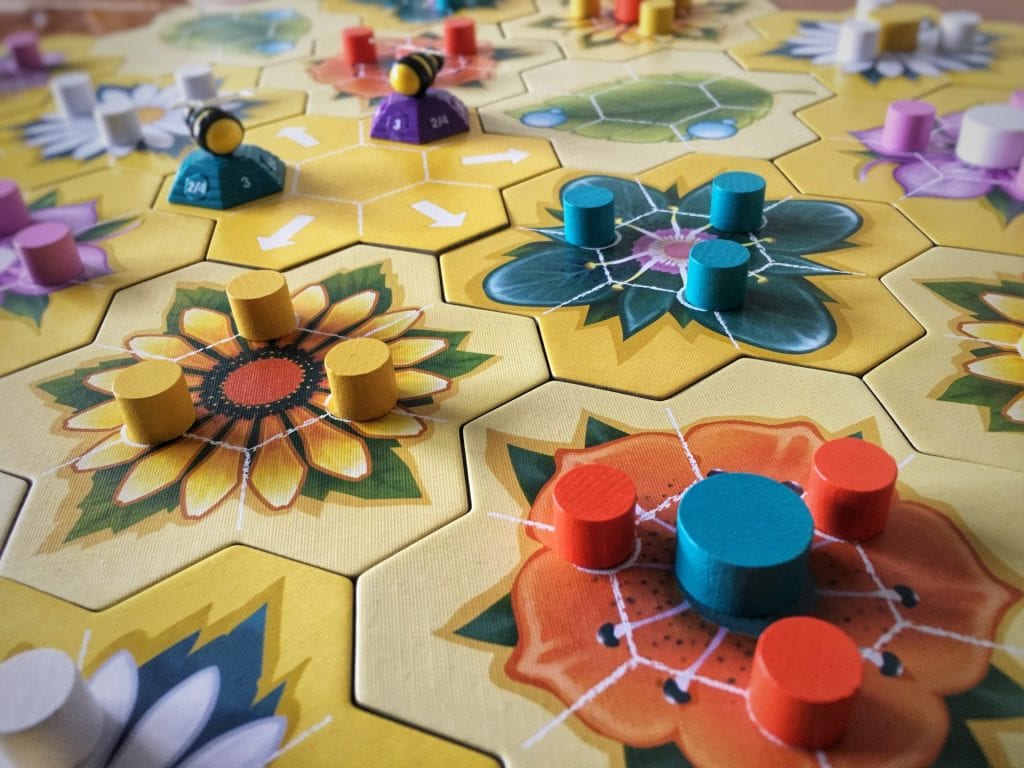
Most bees have a preference of what they gather: pollen or nectar, but all bees can gather both — and some do!
The goal of each player is to collect Nectar from the Flower tiles with their Bee, add this Nectar to their Honeycombs (player board), and do both of these in such a way that they score (honey) points from common and secret Objective cards set up at the beginning of the game.
There are three different kinds/colours of Objective cards:
- Purple cards score points for specific colours of Nectar collected in a player’s Honeycomb.
- Blue Objective cards score specific configurations of Nectar in a player’s Honeycomb.
- Red cards give a player points if they fill certain areas of their Honeycomb with Nectar.

At the start of the game, one Objective card of each colour is placed faceup; these are the common objectives that all players may score at the end of the game. Players are also given one Objective card of each colour. From this hand of three, they choose two to keep and discard the other. These two cards make up a player’s secret objectives that only they may score at the end of the game.
The Objective cards are meant to look like jars of honey. For one jar of 500 g of honey, a single bee would have to make 40,000 trips to collect the nectar (that’s about the same distance as making three orbits around Earth). – From the rulebook.
Flight Path – A Player Turn
A player turn in Beez goes through three phases: Flight Plan, Fly & Collect Nectar, and Store Nectar.
Flight Plan
In the first phase of your turn, you must determine where your little Bee will travel, but since bees are very precise, organized insects you can’t just travel anywhere. The numbers on the base of your Bee will tell you in which direction it may travel and how many spaces.
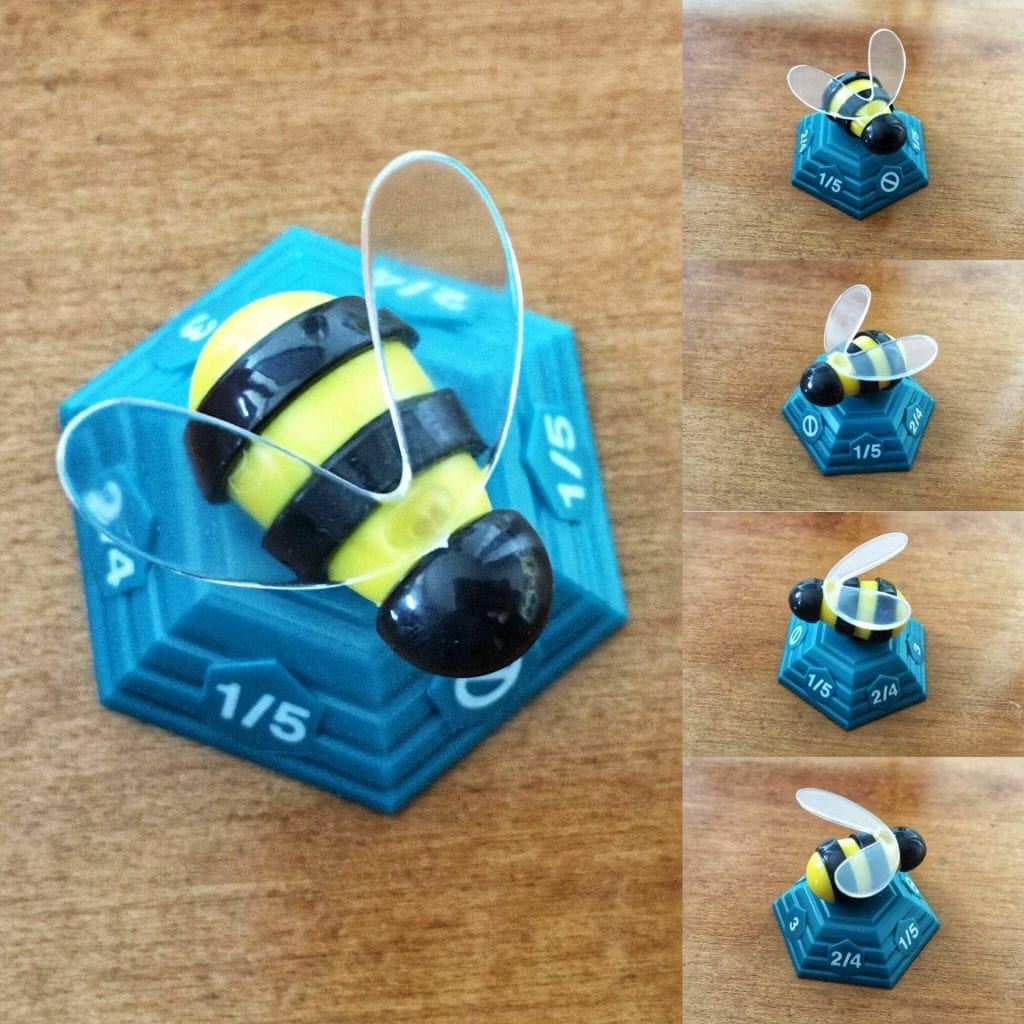
Thanks to their antennae, bees can smell flowers up to 3 km away (just under 2 miles).
After you’ve chosen which direction your Bee will travel, rotate it so its head is facing that direction (the side of the stand that has the ‘prohibited’ symbol) and move it the appropriate number of spaces. Your Bee always flies in a straight line, must remain on the gameboard, and may not end its movement on a space another Bee occupies (although you may pass through these spaces).
Fly & Collect Nectar
Your Bee then collects a small Nectar if there is one on the edge of the space where it ends its movement.
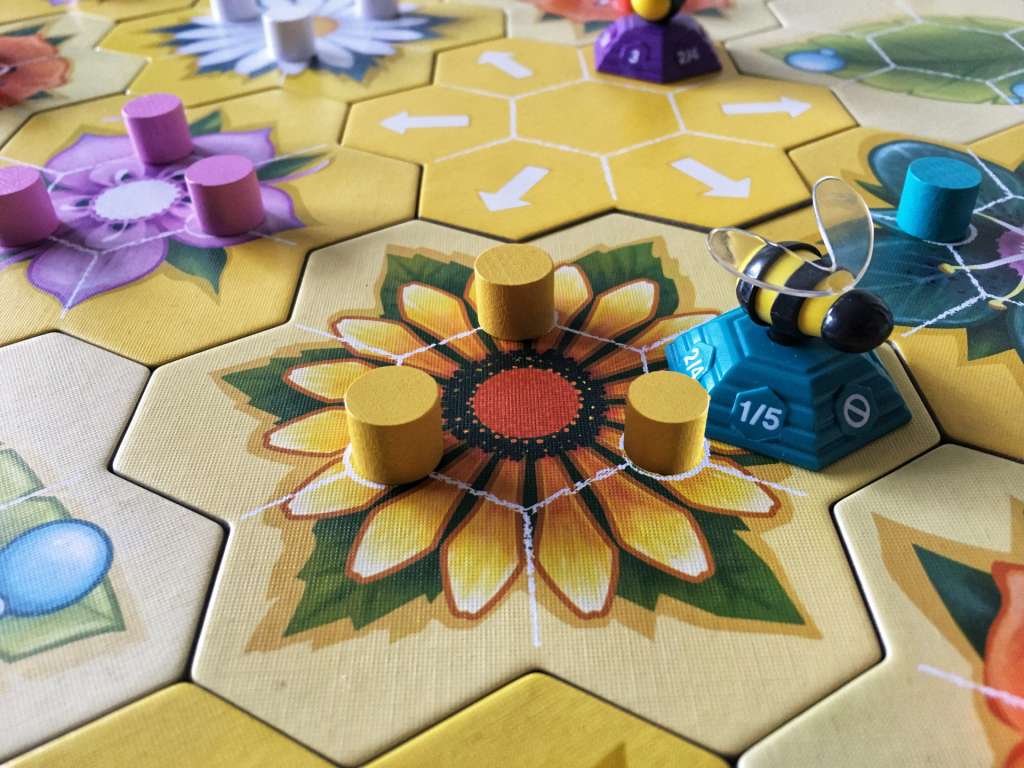
If a Bee ends in the centre of a Flower tile on the edge of the board (where there is also a large Nectar), the player collects both the large Nectar and one adjacent small Nectar (as usual) if there are any available.

If your Bee ends its movement on a space with a water drop (on the Leaf tiles), you don’t get any Nectar; instead your Bee takes a little bath* and, feeling refreshed, immediately takes another flight — which means you get to take another turn.
*Actually bees breathe through their bodies so if they get too wet, they drown. No baths for these fuzzballs! Bees do, however, collect water droplets to help cool down the hive on hot summer days.
There might be times where your Bee ends its flight on a space that has no Nectar, which really stings. Unfortunately when this happens you don’t collect anything that turn, but hopefully you’ve done this strategically and positioned yourself well for your next turn.
Store Nectar
Finally, in the last phase of your turn, you need to store the Nectar you collected in your Honeycomb. To do this, you must place the Nectar in a chamber in a row with a number that corresponds to the distance your Bee flew.
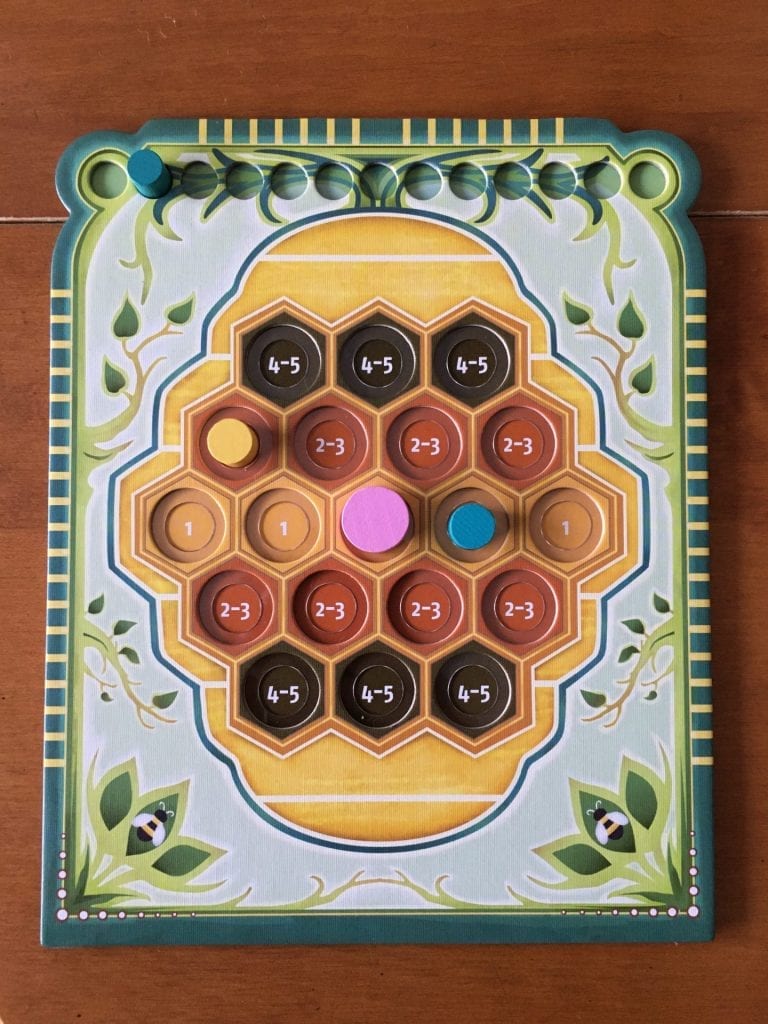
While you must observe the aforementioned requirement, you may place your Nectar in any legal chamber. When doing so, you’ll want to consider both the common and secret objectives because, once placed, a Nectar may not be moved. Strategic Nectar placement could mean that with a single Nectar, you might score more than one Objective card. (Each Nectar may only be used to score an Objective card once, but it may be used to score multiple Objective cards.)
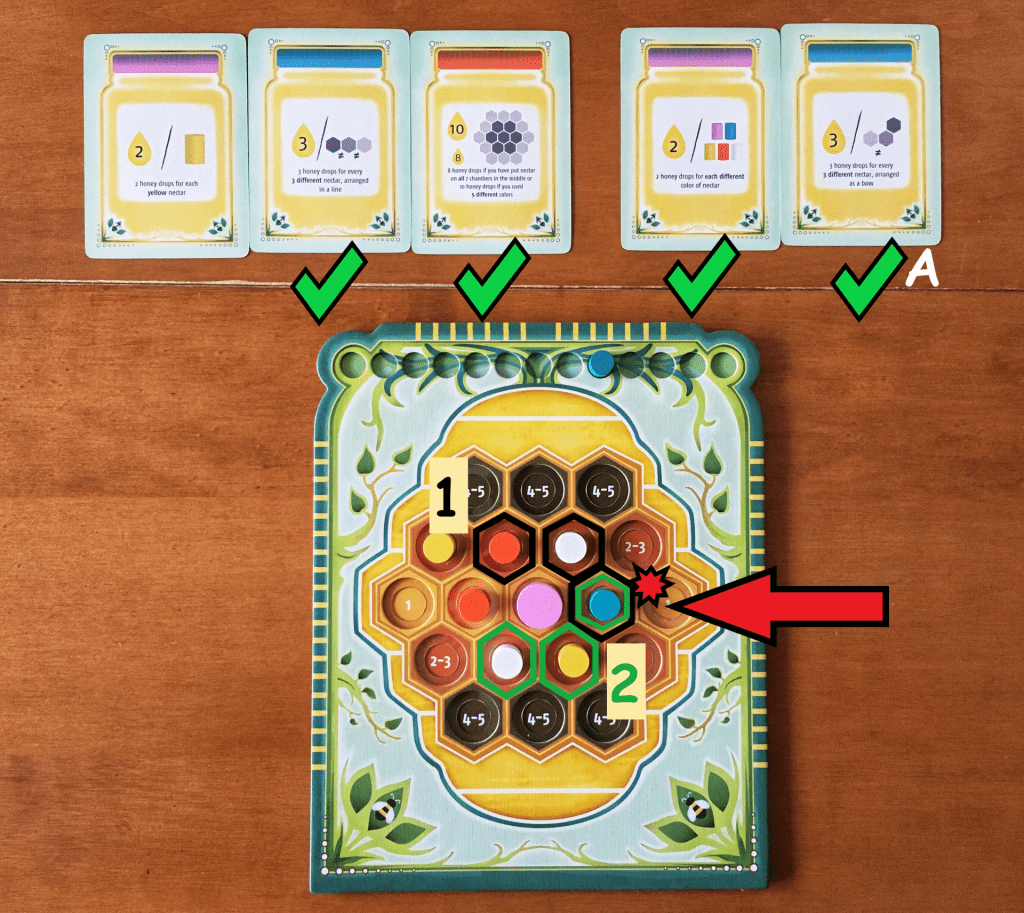
For each Nectar added to your Honeycomb, move your player marker forward one space. Once a player has 12 or more Nectar stored in their Honeycomb (indicated by their player marker reaching the end of the track), the game end is triggered. Finish the round and then each player scores honey drops (points) for the Nectar in their Honeycomb according to the common objectives and their secret objectives.
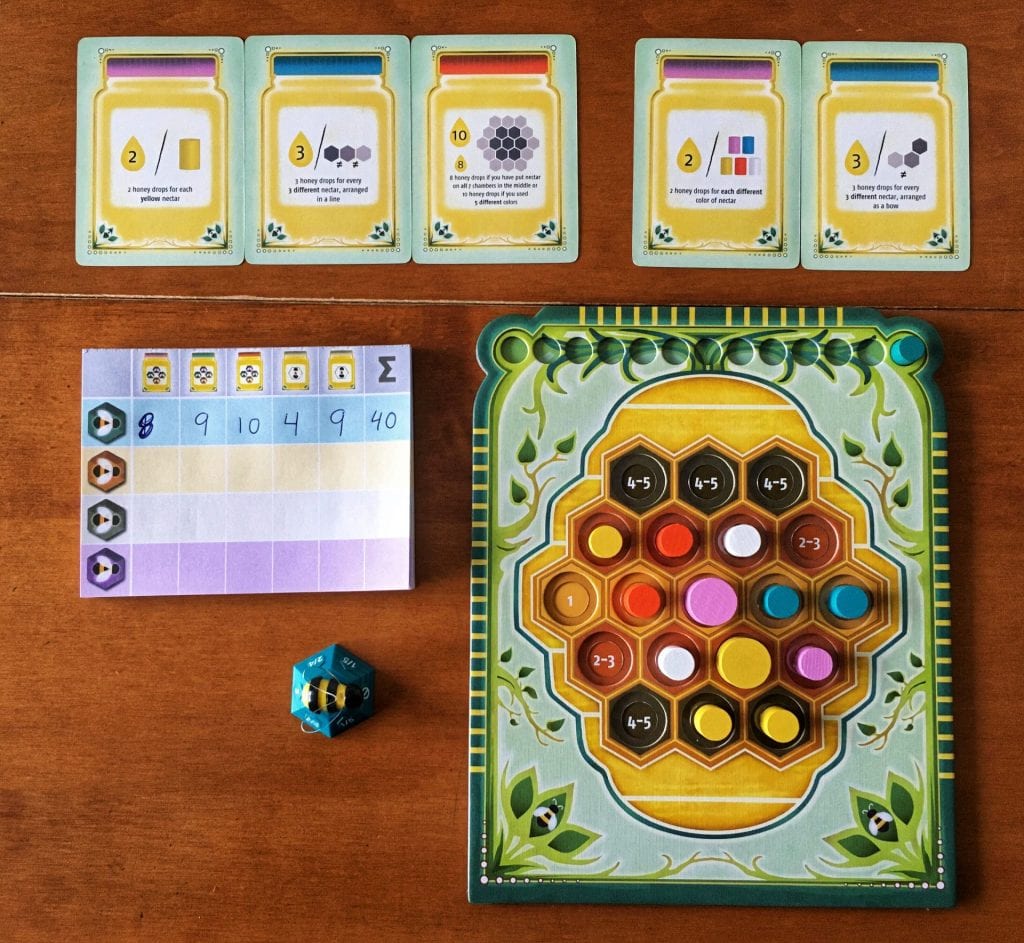
Final Thoughts
2020 was a lot of things…and the year for bee-themed games was one of them, which makes this bee-loving human very happy. I’m even more delighted when bee-themed games turn out to also be great games — and that’s what Beez is.
In this review’s introduction, I mentioned that Beez is essentially an abstract game (and it is), but there were still moments when I was playing the game where I felt like I was watching bees buzz around. What might seem like erratic movement as the players’ Bees change direction and move around the Flower tiles, actually captures the feeling of watching real bees on a warm, sunny day buzzing around a flower garden, hopping from one flower to another. (I found this especially true when I played the game remotely and watched the Bees move between turns on the overhead camera.)
“Waggle dance” is a term used to describe a ‘dance’ performed by honey bees to communicate with each other (like, for example, the direction and distance to a patch of flowers).
Similar to the other games published by Next Move Games, Beez has a simple ruleset, but is deeply strategic. Often I found I was planning — programming even — my moves well in advance so that I could set up my Bee to take two turns in a row, collect two Nectar instead of one, or sometimes take a turn where I didn’t collect anything to then make a big move the following turn. You’re also trying to map out your Honeycomb and decide where you want to place your Nectar so that you can fulfill the objectives — especially when you consider that the Nectar can only be placed in a chamber based on your Bee’s movement. Not to mention you only have about a dozen turns to make your plans come together. All of this makes Beez a very heady, tight, and crunchy abstract game.
Beez is designer Dan Halstad’s first published game.
Another similarity to note between Beez and other Next Move games: the incredible production value. The Bee standees might look fragile, but they are mounted onto a sturdy, weighted base — and, I recently learned, were thoroughly tested by the publisher to ensure their durability. Even the small component details like how the Honeycombs have plastic recesses to snuggly fit both small and large Nectars, are a really nice touch. The storage and insert for the game also feel well-thought out: there are arrows on the vacuum tray to show how to lift it out of the game box, there is a plastic case for the Bees with markings to show how to correctly insert them, and each area of the insert has a marking to indicate what component to store there. The only thing about the insert I find odd is how the Nectar are stored. It looks like there should be an individual row for each colour and size of Nectar, but there isn’t and you have to double up on colours. Perhaps this was a feature that was included to ensure that the components remained in place when the box was stored on its side…because they do!
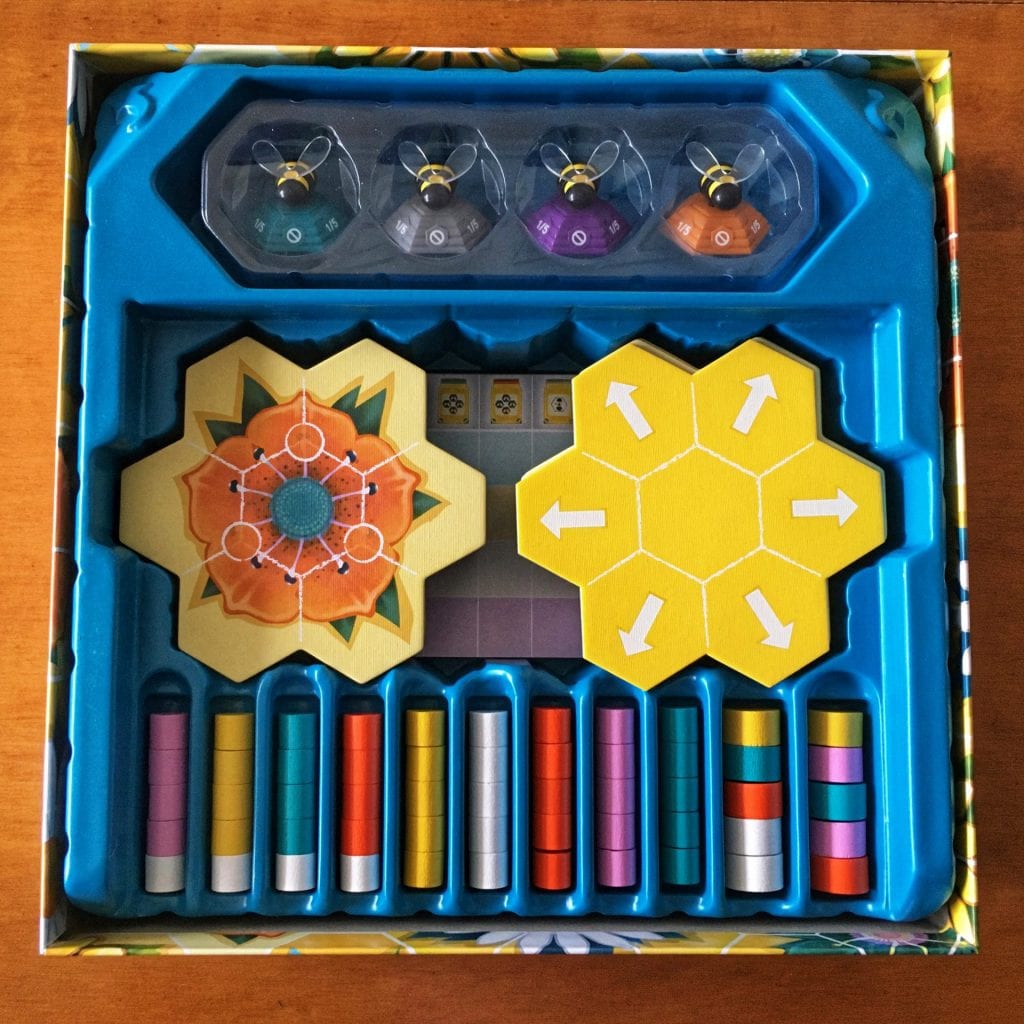
To Beez or not to Beez, that is the question.
For me, Beez is a big win (and even made my top 10 games of 2020). If you like thinky, abstract games with a sprinkling of theme and colour, I think you’ll be drawn to Beez like a bee is to the scent of a flower.

Thematic Music For Playing Beez
I’m not sure how thematic I could get with bee music here — other than creating some sort of playlist with The Flight of the Bumblebee…on loop. As such I’ve decided to, very self-servingly, take this opportunity to share a wonderful documentary on bees by beloved Canadian treasure, David Suzuki. If this doesn’t make you appreciate bees, I’m not sure what will.
Bees are extremely important to our ecosystem; over 75% of all crops rely on pollinators like bees.
Quit pollen my leg, Ashley.
I’m not, Smash. It’s true!
If you’re not able to access the documentary, but would still like to know more about honey bees then check out The Honey Bee and Her Many Duties, a piece written by Meeple Mountain contributor and graphic design extraordinaire Rachel LeCompte.




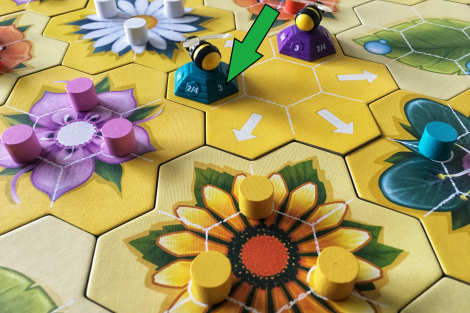

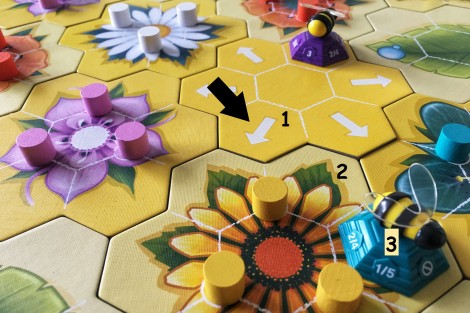


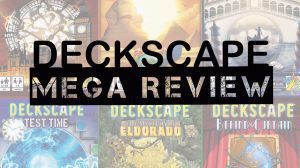





I’ve read Beez came short compared to Reef and Azul, but is there any reason to compare them?
I wouldn’t say so. Despite all 3 games being released by the same publisher and having a similar gameplay weight, they aren’t similar enough to compare. Sure they all feature abstract pattern building in some way, but the mechanisms themselves feel different. I find Reef feels a little like an engine-building game with some hand management, while Azul has the tile placement/set collection, but also tile drafting. Beez feels very much like a traditional abstract strategy game with some pattern building/set collection in the nectar that you take and where you place it on your player board.
Another thing that differentiates Beez from Azul and Reef is that there is no luck or randomness. Beez is a game where players have perfect information and the heart of its gameplay is how players use this information.
Hope that helps shed some light on the Azul vs Reef vs Beez comparison.